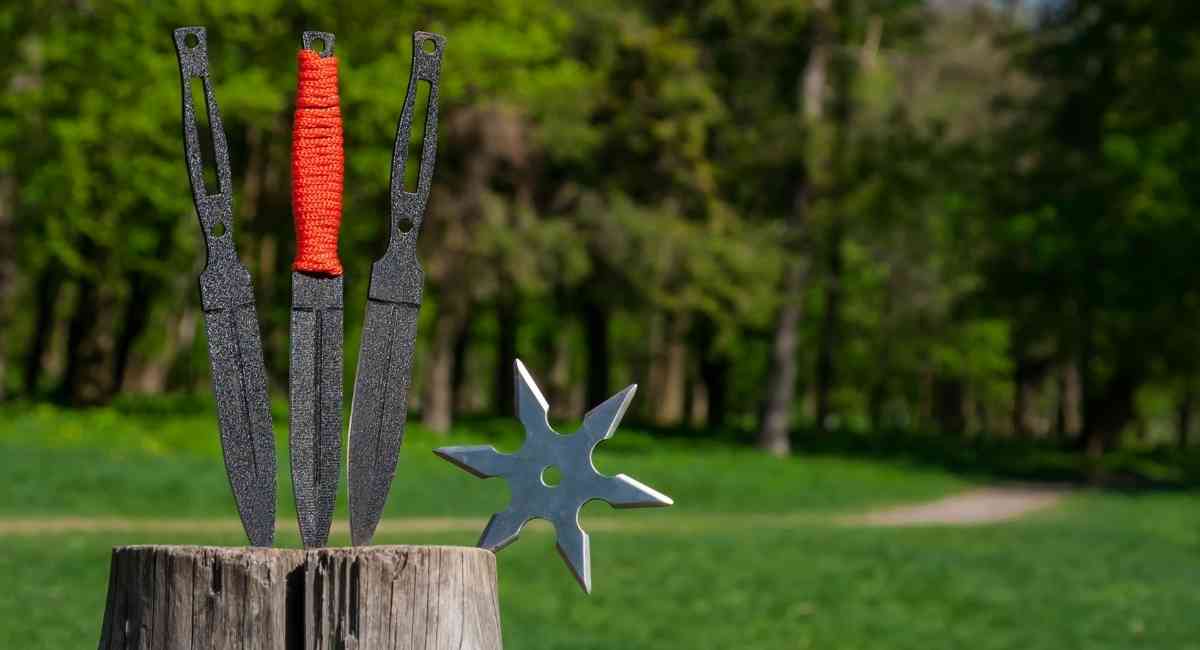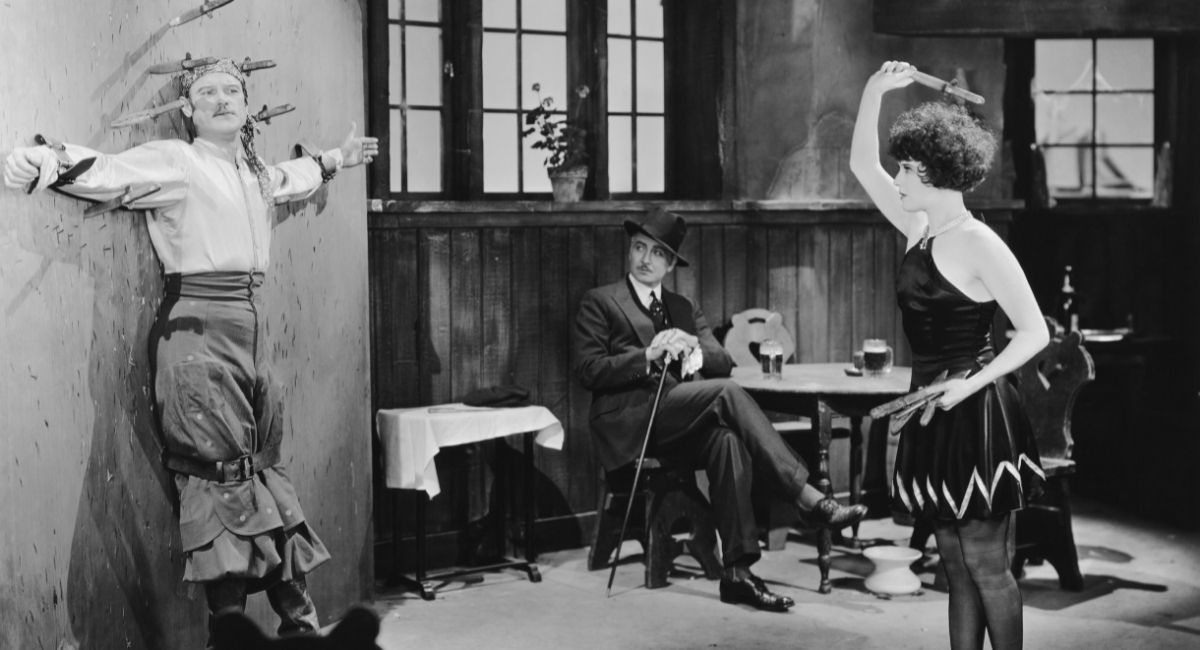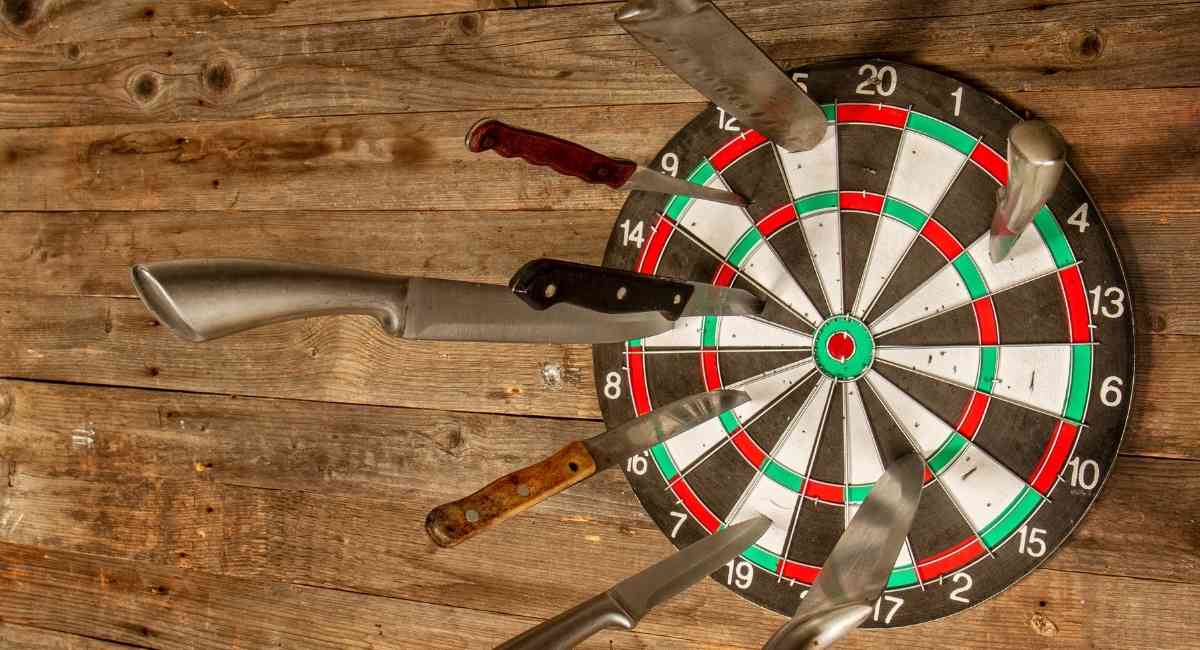How to Knife Throw: Simple Guide For Beginners
The art of knife throwing can be learned and mastered by anyone. If you’re unfamiliar with this hobby and competitive sport, it involves throwing specially designed knives at wooden targets. In this guide, we will show you how to:
- Choose a throwing knife.
- Grip the knife properly.
- Position your body and throw the knife using different techniques.
- Fix errors that cause your knife not to stick to the target board.
Keep reading to find out how to knife throw.

Types of Throwing Knives
Throwing knives come in many different sizes, lengths, shapes, and designs, but a few characteristics remain the same in all competitive throwing knives.
They typically have a pointy tip and a blunt blade.
The tip is sharp and pointy, which allows the knife to stick to the target, and the edges are blunt because professional knife throwers like to hold their knives by the blade.
There is no reason for the blades to be sharp in the sport of knife throwing.
Another characteristic is the distribution of the weight along the length of the knife. Some knives are handle-heavy, some are blade-heavy, and some are equally balanced.
Most of the weight is concentrated in the handle of a handle-heavy knife. With a blade-heavy knife, most of the weight is concentrated in the blade. A balanced knife has a balanced weight distribution.
In terms of the knife’s overall weight, it should neither be too light nor heavy. A knife weighing an average of 200 grams is ideal for most knife throwers, although a heavier knife may be better for throwing over longer distances.
This is because the more mass an object has, the more momentum it can carry to it’s target.
Some of the most popular knives used in knife throwing are the combat knife, the kunai, the bowie, and the dagger.
How to Grip a Throwing Knife
We talked about weight distribution in throwing knives earlier in this guide.
Where you should hold the knife depends on how the weight is distributed. The general rule is that you hold the knife at the heavier end. You might ask – even if the blade is heavier? The answer to that question is yes.
As for balanced knives, they can be held at either end. Learning proper gripping methods is essential in learning how to knife throw.
There are two main types of grip used in this sport: the pinch grip and the hammer grip.
Pinch Grip
This technique looks like it sounds. The thrower holds the knife between the thumb and tips of the other fingers.
This approach is ideal for gripping a lighter knife. When holding a larger, heavier knife using this grip, the thrower may need to use more of the surface of their fingers and hand.
With a pinch grip for heavier knives, do not enclose the knife in the palm of your hand. Your thumb should be pressing on the handle, pinching it instead of grasping it.

Hammer Grip
This gripping technique also looks like it sounds. The thrower holds the knife the same way one would hold a hammer. Throwing using this grip causes the knife to rotate faster than when using the pinch grip. For a hammer grip, you’ll want to:
- Grasp the handle of the knife in the palm of your hand.
- Wrap your four fingers around the handle, with your thumb overlapping those fingers.
- Grasp it firmly enough so that you can release it well, but not too tight that it goes off course.
How to Throw the Knife
Stance
Proper stance is key to accuracy and a good throwing technique. The best way to position yourself is to stand square with your body facing the target directly.
Next, step your dominant foot (the foot on the same side as your throwing hand) in front of your other foot at a comfortable angle and width. Bend your knees slightly to help you maintain your balance.
Raise your arm and bend your elbow so that your upper arm is perpendicular to your body.
Throwing With the Pinch Grip
- Position yourself in the proper stance.
- Grip your knife correctly.
- Raise your arm and bend your elbow so that your upper arm is perpendicular to your body.
- Bring the knife as far back as you want to go, keeping in mind the size and weight of the knife and the distance between you and the wooden target.
- Swiftly swing your forearm forward and throw the knife, lengthening your arm and maintaining your stance as much as possible.
- Follow through the motion with your arm.
Throwing With the Hammer Grip
- Get into the correct stance.
- Grip your knife correctly.
- Bend your elbow and raise your arm backward behind or in line with your ear.
- Throw the knife by swiftly bringing your arm forward, then down, leaning forward while completing the motion. Remember to maintain a proper stance.
- Follow through by continuing the downward swing to improve accuracy.
Knife Throwing Techniques
Two main techniques are used in the art of knife throwing: the spin technique and the no-spin technique.
No-Spin Technique
This approach sounds like how it looks – the knife has no spin on it while traveling through the air.
To throw a knife with no spin on it, hold the knife with a proper grip, then place your index finger on the back of the knife instead of where you would put it in the pinch grip or hammer grip.
Now, throw the knife, and release it with your index finger, using good posture and follow-through.
Spin Technique
This approach is used to rotate the knife while it is traveling. Several factors contribute to the amount of spin on your knife.
These include how far you are from your target, how much you flick your wrist, how high up on the handle you hold the knife, and how much force you put into your throw.
There are different variations of the spin technique, the most popular being the half-spin and full-spin.
To throw a knife with full spin, follow these steps:
- Hold the knife low on the handle with the tip of the blade pointing upward (handle-heavy knives are the most suitable for this technique).
- Use a pinch or hammer grip for this method, depending on your knife’s type, size, and weight.
- Follow steps 3 to 5 of the “throwing with the hammer grip tutorial” above.
To throw a knife with half-spin, follow these steps:
- Hold the knife low on the blade, with the tip pointing downward (blade-heavy knives are ideal for this technique).
- Follow steps 4, 5, and 6 of the “throwing with the pinch-grip tutorial.”
Remember, the distance between you and your target has a lot to do with the rotation of the knife. You can only figure out the right distance and throwing angle for you through practice.
Fixing Errors With Rotation
We mentioned earlier that several factors contribute to how much your knife rotates when you throw it. Your knife can either over-rotate or under-rotate. Below are some tips to fix these problems.
To fix over-rotation:
- Hold the knife higher on the handle or blade.
- Move closer to your target.
- Hold the lighter end of your knife to point in the direction of the target.
To fix under-rotation, do the opposite of the instructions above for a more accurate throw.
Safety Precautions
Although people do knife-throwing as a hobby or as a sport, there is still a significant level of danger involved in this practice. Both experienced and novice knife throwers must take all the necessary safety precautions.
These include ensuring that the throwing area, like a shooting range, is clear of people and animals and wearing shoes that properly cover your feet and can withstand knife penetration.
You should also choose a suitable type of wood to make your target boards.

How to Knife Throw – A Quick Recap
Now that you understand how to knife throw, let’s quickly recap the basics.
- Choose the type of knife that you feel most comfortable with. It is a good idea to try out different sizes, weights, and designs.
- Practice holding the knife correctly – get familiar with the pinch grip and hammer grip.
- Practice the correct stance.
- Hold the knife between your thumb and other fingers to do the pinch grip. Avoid enclosing it in your palm.
- To do the hammer grip, hold the knife’s handle just like how you would hold a hammer.
- To throw with no spin on the knife, keep your index finger on the back side of the knife while releasing it.
- Practice using the full-spin and half-spin techniques.
Have fun practicing your knife throwing, and remember that safety always comes first.
